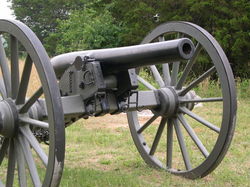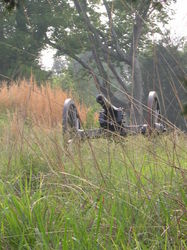George W. Hicks 1845-1863
George W. Hicks, UNION
Joined August 13, 1862 at Hardin County, IL. (joined with brother Miles and soon to be brother-in-law James Carlisle)
Joined by Cpt. Hobbs.
Mustered in on November 13, 1862.
Private.
Company F, 131st IL Infantry.
According to the IL archives...
Residence: Hardin County, IL
Age: 18
Height: 5'6"
Hair: Light
Eyes: Blue
Complexion: Light
Marital Status: Single
Occupation: Farmer

Regiment history...
The One Hundred and Thirty-first Infantry was composed of men from the counties of Hamilton, Gallatin, Hardin, Pope and Massac. They were enlisted during the months of July and August, 1862. By order of Govenor Richard Yates, it was organized and went into camp at old Fort Massac, Massac county, Illinois, in September, 1862, and remained there in camp until November 18, when it was mustered into the United States service. The Regiment then numbered 815 men, excluding officers.
While at Fort Massac the Regiment was without tents, camps equipage or guns, except a few inferior guns borrowed for use in guard duty and squad drill, but notwithstanding its limited outfit, the guard duty and squad drill was kept up. During this time the measles broke out in camp, and about 100 of the men were prostrated therewith, nearly all of whom either died or were afterwards discharged for disability caused thereby.
After the Regiment was mustered into the service, it was ordered to hold itself in readiness to proceed to Memphis, Tenn., which order was received with joy by all the men, notwithstanding quite a number of them were sick at the time.
On December 2 it embarked on the steamboat Iowa, and proceeded to Cairo, where the men were furnished with guns of inferior quality, being the Harper's Ferry flintlock guns, and three different sizes in caliber, altered for caps, which were received under protest. The Regiment then went on same boat to Memphis, arriving there December 7. It reported to General Hurlbut, and was ordered into camp about two and a half miles southeast of the city, where it found quarters in old stables and outbuildings. Tents were then issued, and a portion of the guns were exchanged for Springfield rifles. The Regiment was assigned to General Landrum's Brigade of General A. J. Smith's Division of General Sherman's Corps, being the Second Brigade of the First Division of the Seventeenth Army Corps of the Army of the Tennessee, which was then preparing to move on Vicksburg.
On December 20 the Regiment again embarked on the steamboat Iowa and took position in the fleet, and moved down the Mississippi. Landed at Milliken's Bend, La., on December 24, where the Regiment was engaged in picket duty until December 27, when it again embarked on the same boat, and with a portion of the fleet moved up the Yazoo River to near Haines' Bluff, where it took part in the engagement at that place, which ended January 1, 1863. It was then returned on board the transports, and that night the whole fleet was ordered to Milliken's Bend, where it remained until January 4.
General John A. McClernand now taking command of the Corps, it started on an expedition against Arkansas Post, moving up the Mississippi on the transports to the mouth of White River, thence through the pass and up the Arkansas River about thirty miles to within about three miles of Arkansas Post, where it disembarked about noon of January 10. The One Hundred and Thirty-first Regiment then marched until about 11 o'clock at night, only making a distance of four miles, the march being through swamps covered with underbrush and fallen timber; then coming to a halt, it formed in line of battle and remained so until daylight next morning. During all this time a snow and rain storm raged unceasingly, and the soldiers were drenched to the skin. On the following day a greater portion of the Regiment was engaged on detached duty, assisting heavy artillery through the swamps; the remainder continued in line of battle on the extreme left. This point the enemy shelled continuously during a greater part of the day, with the view of driving the Union forces from this portion of the woods, and making their escape through the same; but failing to do this, the shelling ceased about 3 o'clock in the afternoon.
The actual fighting at Arkansas Post lasted only about four hours, when the fort with its entire forces surrendered.
The Regiment remained at this point four days, burying the dead, filling ditches, and demolishing fortifications; during all of which time it was exposed to one continuous storm of rain and snow. On January 15th it again embarked on the steamboat Iowa and headed toward Vicksburg. On January 23rd, landed at Young's Point, and two days later disembarked and went into camp on a spot surrounded by a levee. Here the rain poured down almost incessantly; the river was out of its bank, the surface of the river striking the outside of the levee was twelve inches higher than the ground emcamped on. While here every man at all able for duty either worked to his full capacity with pick, shovel and axe in the canal through which it was expected to turn the river, or did duty on the picket lines, when to get to their posts on the picket lines they were compelled to wade in water to their waists. A large number of the men while encamped here were prostrated with sickness, some with measles, some with small pox and some with pneumonia; and the regimental surgeon was unable for duty, and each day those free from sickness had the sad duty to perform of burying from one to five of their companions in the levee, who had died of disease. The Regiment remained at this point--its ranks continuing to be lessened by disease and death--until March 2, 1863, when by order of General McClernand, it embarked on steamer Westwind for Memphis to recruit its health. Arrived at Memphis March 6th and went into camp at Ft. Pickering where they remained until May 9th.
The Regiment was now greatly improved in health and spirits, but its ranks only numbered about 400 men, the rest having been killed, died, or disabled and sent to hospitals. On May 10th it left Memphis on steamboat Golden Era for its third voyage to Vicksburg, accompanied by a gunboat and steamers Crescent City and Warren, which had on board the Sixty-third, Eighty-seventh and One Hundred and Twentieth Illinois Regiments. When near the foot of Island No. 82, The Golden Era, being in advance and running near the shore was fired into by a band of about 100 guerrillas, who were secreted behind drift logs on the bank, wounding one man fatally and two slightly, and killing a mule. The men returned the fire but with what effect could not be told, as the band disappeared at the sight of a little cloud of smoke that floated up from the port hole of the gunboat, which was a short distance in the rear. The Regiment arrived at Sherman's landing on May 12th, and then on the 17th moved up to Milliken's Bend, and relieved the Thirtieth Ohio that was on duty there, and remained there guarding army supplies from the numerous guerrilla bands which infested that locality until May 24th, when it returned to Sherman's Landing on steamer Fanny Bullett and encamped in full view of the city of Vicksburg. A part of the Regiment then did duty on the picket line on the point opposite Vicksburg, and the balance in manning mortar boats.
On June 7, the One Hundred and Thirty-first, together with the One Hundred and Twentieth Regiment, was ordered to Milliken's Bend to support a colored regiment of about 300 or 400 men, and 120 men of the Twenty-third Iowa, who had been attacked by about 1200 rebels. In five minutes after the first tap of the drum, the One Hundred and Thirty-first Regiment was in line and in ten minutes they were on board the transports, the One Hundred and Twentieth Regiment soon following and in about one hour they were in line of battle at the Bend, but the rebels had retreated at sight of the gunboats. The Regiment remained there two days expecting an attack, but as none was made it was again ordered to Sherman's Landing, where it continued on its picket duty and manning mortar boats until the surrender of Vicksburg, July 4, 1863. Shortly after the surrender it moved to the city.
Burial...
George was stricken with diarhea and was taken to a convalescent camp. On July 10, 1863, George at the age of 18, passed away and died close to Young's Point, Louisiana.
